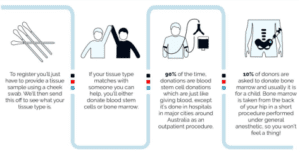Saturday September 19, 2020
The Leukaemia Foundation is calling for Australians to mark World Marrow Donor Day by signing up to donate their stem cells in a show of support for 600 Australians living with blood cancer whose lives depend on an allogeneic stem cell transplant every year.
Every 31 minutes, someone in Australia is diagnosed with blood cancer, and for many, a blood stem cell transplant from a complete stranger is their only hope of surviving their diagnosis. But thanks to a simple test, the chance for anyone to save the life of an Australian living with this disease couldn’t be easier.
Last year, the Australian Donor Registry launched a ‘Strength to Give’ campaign, to encourage young people aged 18-35 from a diverse group of ethnic backgrounds to register to become an Australian stem cell donor by using a simple cheek swab to check whether their tissue type matches with someone in need of stem cells or bone marrow.
As the successful campaign reignites once more, the Leukaemia Foundation is again joining forces with the Registry to boost donor numbers, with the latest push aiming to secure a further 6000 Australians to step forward and swab a cheek in a bid to add their name to the registry and save a life.
More than 70% of Australians living with a blood cancer requiring a stem cell transplant must look outside their own family to find a donor, leaving them reliant on Australians to be registered to donate, and looking to the Australian Donor Registry to source a suitable match.
But with less than 5 per cent of registered donors considered ideal, the Registry often can’t meet these needs, forcing a search for potential donors overseas for this vital treatment option. Sadly, in cases where the patient is or identifies as being an Indigenous Australian or hails from a community underrepresented in international registries, a suitable donor can’t be found.
Leukaemia Foundation Acting CEO Alex Struthers said World Marrow Donor Day was not only a chance to celebrate and thank blood stem cell donors worldwide, but also to draw awareness to the reality that access – or no access – to donated stem cells acts as a crucial factor determining survival for hundreds of Australians fighting blood cancer.
“The Leukaemia Foundation is focused on breaking down barriers to ensure all Australians affected by blood cancer have access to the best treatment, information and supportive care, because we know these barriers impact survival,” she said.
“It is simple – the more registered Australian stem cell donors there are, the greater the chance of survival for Australians living with blood cancer, and the closer we all step to seeing zero lives lost to blood cancer by 2035.”
The Australian Donor Registry is especially interested in registering particular members of the community. Younger donors result in better outcomes for patients, so 18-35 year olds are encouraged to register to increase chances of finding the best possible match. Additionally, young men are also considered particularly important donors – as they often weigh more, they literally have more to give. Ethnic diversity is also important as patients are more likely to find a match with a donor from the same ethnic background.
To register to become a stem cell donor, simply visit https://strengthtogive.org.au/ and register your details and a swab test will be sent to you. Once this is returned, you will be placed on the Australian Bone Marrow Donor Registry.
For more information on stem cell transplants, visit https://www.leukaemia.org.au/disease-information/transplants/ or visit the Leukaemia Foundation’s Blood Cancer Information YouTube Channel.
END
What is a Blood Stem Cell Transplant?
- Blood stem cell transplant is also known as bone marrow transplant. This treatment may be recommended for people with blood cancers such as leukaemia, myeloma or lymphoma.
- A stem cell transplant replaces blood-forming cells in your bone marrow (including cancer cells) that have been destroyed by chemotherapy or radiation therapy with healthy stem cells. These cells then develop into new bone marrow and produce healthy blood cells.
- A blood stem cell transplant can use a patient’s own stem cells (autologous transplantation) or stem cells from a donor (allogeneic transplantation). This can be a complex decision that will depend on several factors, such as your age, the type of cancer you have, the health of your existing bone marrow and your overall health, and any previous chemotherapy treatments.
Who is the Australian Donor Registry?
- The Australian Donor Registry is an independent charity, part-funded by the Australian Government to provide hospitals with the ability to search for matching stem cells from unrelated volunteer donors from Australia and around the world.
- The chances of finding a match for Australians in need depends on the characteristics of the donors. To find the best possible match, patients need donors from an ethnic background similar to their own. Some Australians will find a matching donor in countries like the UK, US or Europe; for others, a matching donor will only be found in Australia. For more information, please visit https://www.abmdr.org.au
